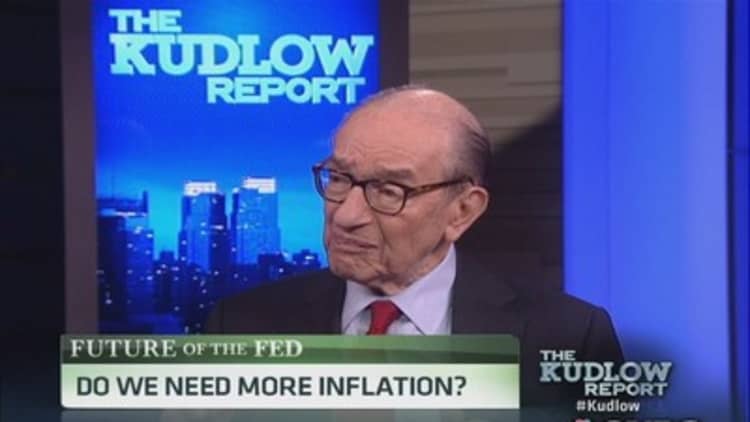As the world's main central banks try to battle the threat of stagnant growth and falling prices by implementing inflationary measures, one option for yield available to investors is emerging market bond plays.
However, while some analysts point to the gains to be made in the trade, others warn that the market for emerging market inflation-linked bonds, often called "linkers," is too limited to be worth betting on.
Ben Bernanke, the current Federal Reserve Chairman, warned last week that inflation must be prevented from declining too far from the central bank's 2 percent goal.
(Read more: Could QE spur deflation, not inflation?)

Meanwhile, in the euro zone, October inflation data surprised on the downside, falling to a nearly four-year low of 0.7 percent from a year earlier, boosting deflation fears and spurring a surprise rate cut by the European Central Bank to a fresh record low of 0.25 percent.
(Read more: Is the euro zone at risk of Japan style deflation?)
Japan has battled persistent deflation and anemic growth for nearly two decades, with the Bank of Japan this year launching a massive easing program in an effort to spur its economy out of stagnation.
Governments typically issue inflation-linked bonds, which link capital appreciation to inflation if held to maturity, to reduce borrowing costs, as buyers pay a premium for protection, especially when inflation expectations are too high; issuing the bonds also adds credibility to government and central bank efforts to keep inflation low.
But when deflation is the fear, creating inflation isn't necessarily seen as a negative.
(Watch: The Threat of Deflation)
"It is absolutely axiomatic for the big three central bankers of the world now that they are going to fight tooth and nail to avoid deflation and they've made it that more urgent by the amount of debt that's been issued," said Nicolas Rohatyn, CEO of Rohatyn Group, which has more than $7 billion under management, at the AVCJ Asian Private Equity & Venture Forum in Hong Kong last week.
"If deflation was a problem before, with what it did to borrowers, it's a much bigger problem now. I think if there is one unifying theme for central bankers – U.S., Europe, Japan – it's create inflation, " he said.

"They have a lot of tools to create it. I don't think one should bet against them," he said.
(Read more: )
Instead, he advises that investors should play the inflation theme via emerging market linkers issued in countries' local currencies.
"There are not that many instruments that have some liquidity, that have some coupon, that are not totally speculative in nature that allow you to participate in that intelligently. I think this is the best asset class for that particular view," he said.
As inflation returns, thanks to the central banks' efforts, investing in the bonds may also offer currency gains, Rohatyn said. He expects inflation will cause emerging market currencies to appreciate against their developed market counterparts.
(Read more: Fed will get its inflation; here's who will pay)
But others say the risk involved in playing emerging markets' inflation-linked bonds is too great.
Will Oswald, global head of fixed income, commodity and currency research at Standard Chartered warns that the amount of money in the market and the small number of the bonds available make it too risky a bet.
"Within Asia, it's not a market that exists in any sort of meaningful size whatsoever," making it difficult to get a diversified emerging market exposure, he said, noting issuance is primarily in Brazil, Mexico, Turkey, Poland and South Africa.
"The ability to exit could also be constrained" by the markets' limited liquidity, he said.
Oswald doesn't expect a large jump in interest rates to emerge from the easing measures in developed market central banks, saying rates are more likely to normalize due to a pick-up in economic growth.
(Read more: Here's a 'TIP': Time to get ready for inflation)
In addition, in many emerging markets, the risk may be deflation, not inflation, once central banks begin unwinding their monetary stimulus as it may spur fund outflows, he noted.
"I don't think it's a compelling opportunity," Oswald said.
So far, the market appears to agree, with U.S.-listed international inflation-linked bond funds underperforming their nominal rate peers.
For example, Pimco's Global Advantage Inflation-Linked Bond Strategy Fund (symbol: ILB) , which contains both developed and emerging market bonds, is down more than 10 percent year-to-date, while the iShares International Inflation-Linked Bond ETF is off more than 8 percent year-to-date. By way of comparison, SPDR Barclays International Treasury Bond ETF is only down around 3 percent so far this year. Inflation-protected bond funds saw outflows of $4.8 billion in October, according to data from Lipper.
Indeed, local-currency emerging market bond funds have seen sharp outflows this year, with around $8.93 billion flowing out of the segment through November 13, according to data from Jefferies.
— By CNBC's Leslie Shaffer. Follow her on Twitter: @LeslieShaffer1

